#12: Testing times for JWST
16 June 2017
The journey to launch for the James Webb Space Telescope (JWST) is – literally – a testing time for the groundbreaking observatory. After demonstrating that it can come through the ordeal of vibrations and loud sounds associated with a launch, the telescope and its instruments have now been moved to Houston, Texas, for a final three-month test campaign in frigid, sub-zero temperatures.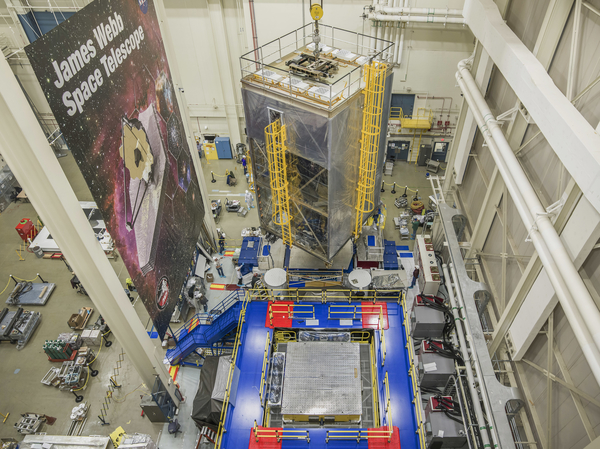 |
| Vibration testing on the James Webb Space Telescope. Credit: NASA/Chris Gunn |
The year began with the recommencement of the programme of vibration testing of the combined Optical Telescope element / Integrated Science instrument module (OTIS) at NASA's Goddard Space Flight Center, in Greenbelt, Maryland.
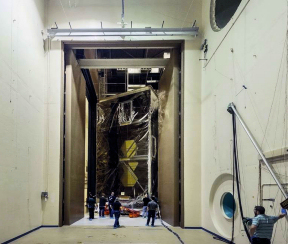 |
| NASA's JWST Team prepares for earsplitting acoustic test. Credit: NASA/Chris Gunn |
The tests had shut down automatically on 3 December 2016, due to some accelerometer sensor readings that exceeded predicted levels. After a thorough investigation, the JWST team determined that the cause was extremely small motions of a tie-down or "launch restraint mechanism". These latches are designed to hold in place the wings of JWST's 6.5 m primary mirror when they are folded-up in launch configuration.
Based on the results of this investigation and after making some changes to the test procedure, the engineers also concluded that it was safe to proceed and it was decided to resume the vibration and acoustics testing on 25 January. Over the next two months, this phase of environmental testing was completed successfully as OTIS was shaken along all three axes at up to 100 times per second and subjected to ear-splitting noise levels in an acoustic test chamber.
As is customary after conducting such stressful tests, the team then checked that the many functions of the telescope and its instruments were still in good shape. As part of that process they repeated a series of optical tests that were previously undertaken last year. These involved the use of a specially designed interferometer, an instrument capable of measuring the shape of and position of JWST's primary mirror with incredible accuracy.
 |
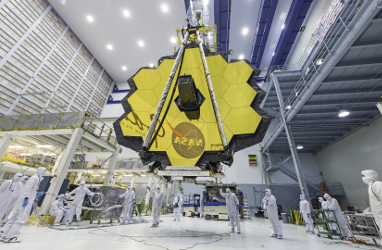 |
| JWST lights out inspection. Credit: NASA/Chris Gunn |
JWST mirror seen in full bloom. Credit: NASA/Desiree Stover |
During the test, temperature and humidity conditions in the clean room were kept as stable as possible to minimise drift in the sensitive optical measurements over time. To avoid tiny vibrations in the clean room that could cause jitter during measurements, the 'high-speed' interferometer was designed to take 5000 'frames' every second - faster than the background vibrations themselves. This allowed engineers to subtract any jitter and obtain precise measurements. The team concluded that the mirrors passed the test with flying colours.
This completed a major step toward demonstrating that the various elements of JWST can survive the stresses of a launch on its Ariane 5 rocket and cleared the way for the next phase of testing at NASA's Johnson Space Center.
OTIS was packed in its special transportation container, known as the Space Telescope Transporter for Air Road and Sea (STTARS), loaded onto a trailer truck and flown to Houston in Texas.
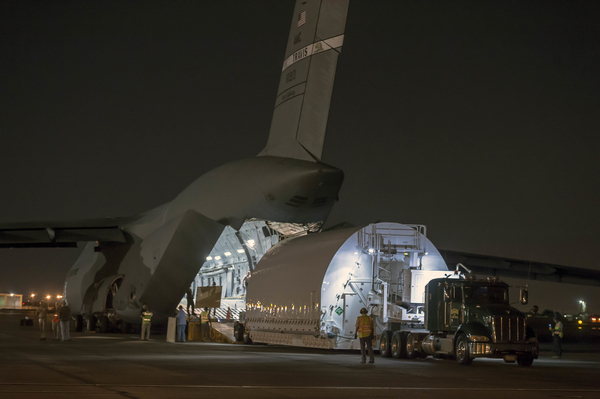 |
| JWST arrives in Houston. Credit: NASA/Chris Gunn |
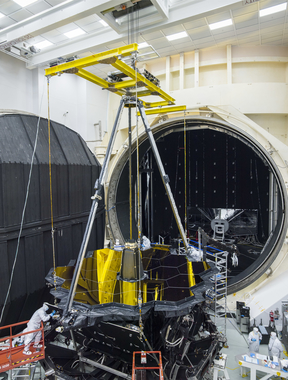 |
| JWST OTIS at Johnson Space Center. Credit: NASA/Chris Gunn |
There, over the next three months, it will undergo final cryogenic testing of its optics. This will take place inside Thermal Chamber A, the largest high-vacuum, cryogenic, optical test chamber in the world. The interior of the chamber measures 16.8 m in diameter and 27.4 m high. Originally built for the Apollo Moon programme in the 1960's, the chamber was completely refurbished and it can now reduce temperatures to just 20 degrees above absolute zero (minus 253 degrees Celsius).
This will be the first and only time that the complete OTIS system has been tested in these conditions. It will also be the final opportunity to test the two European instruments on JWST, the Mid-Infrared Instrument (MIRI) and the Near-InfraRed Spectrograph (NIRSpec).
These critical tests will mostly involve optical checks of alignment and potential stray light paths. This is far from easy, because the configuration of the telescope will be affected by gravity, unlike when it is operating in space. The tests will verify the performance of the complete telescope at the extremely cold operating temperatures it will experience when operating in deep space.
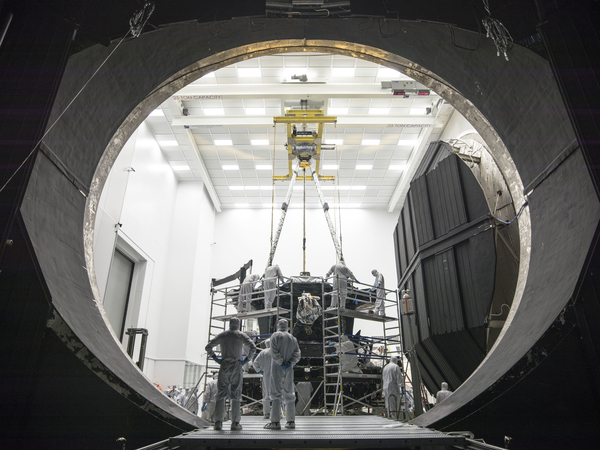 |
| A view from Chamber A. Credit: NASA/Chris Gunn |
In November, JWST will be sent to Northrop Grumman Aerospace Systems in Redondo Beach, California, for final assembly and testing with the spacecraft bus and sunshield, prior to launch in 2018 from the Europe's spaceport in Kourou, French Guiana.
Meanwhile, in parallel with this testing, teams of astronomers located across the United States, Canada, and Europe have started to write proposals for scientific observations that will take place with JWST in 2019, once the observatory has reached its final orbit and is ready for science.
The selection of the proposals will be a highly competitive process, similar to the one in place for the Hubble Space Telescope. Currently, the JWST teams are working hard to make sure the scientific community is ready to use JWST. One example is a dedicated workshop that will take place at the European Space Astronomy Centre (ESAC), Spain, in October 2017.
ABOUT JWST
The James Webb Space Telescope (JWST) will be a general-purpose observatory with a 6.5-metre telescope optimised for infrared observations and a suite of four astronomical instruments capable of addressing many of the outstanding issues in astronomy. The primary aim is to examine objects which formed shortly after the birth of the Universe in the Big Bang, almost 14 billion years ago. Further aims include: looking at how galaxies form; the birth of stars; and the search for protoplanetary systems and the origin of life, including the study of exoplanets. JWST is a joint project of NASA, ESA and the Canadian Space Agency. It is scheduled for launch in 2018 on an Ariane 5 and will operate approximately 1.5 million kilometres from the Earth in an orbit around the second Lagrange point (L2) of the Sun-Earth system.








